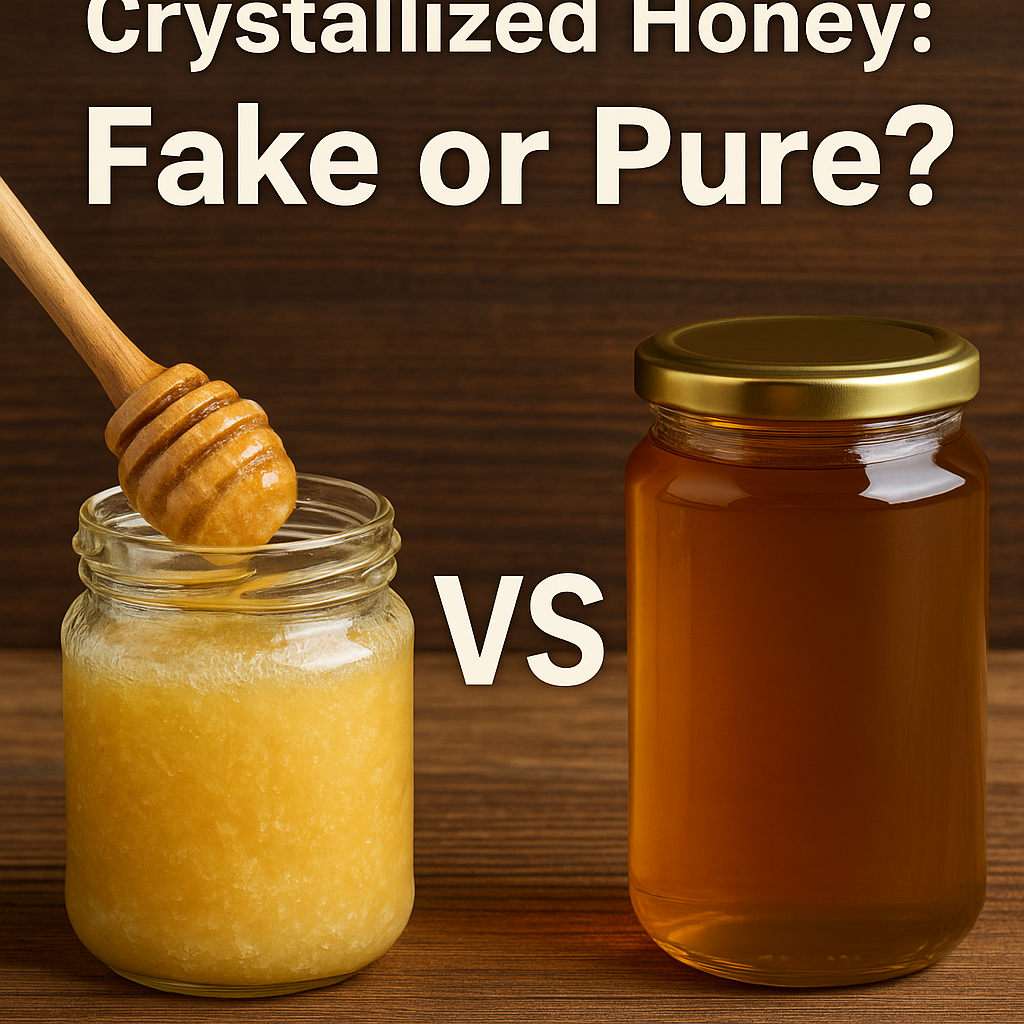Is Your Honey Crystallized? Here’s What It Really Means
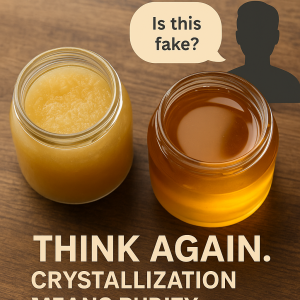
If you’ve ever opened a jar of honey only to find it thick, grainy, or semi-solid, your first thought might be: “Has it gone bad?” or “Is this fake?”
You’re not alone.
In fact, many people assume that crystallized honey is adulterated or expired. This belief stems from a widespread myth that “pure honey doesn’t crystallize.” However, that idea is simply wrong.
The truth is, when honey crystallizes, it signals purity. Real, raw, and unprocessed honey naturally undergoes this transformation over time. On the other hand, honey that never crystallizes usually goes through heavy processing or adulteration—not something you want in your kitchen.
Let’s dive deeper into the science behind this natural change and understand why crystallization is not a flaw, but a feature of genuine honey.
Why Real Honey Crystallizes
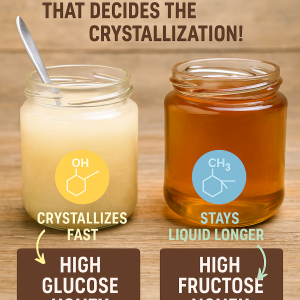
To understand crystallization, we need to know what honey is made of.
Honey contains two main natural sugars: glucose and fructose. These sugars come from the nectar bees collect, and their ratio varies depending on the flower source.
-
Glucose dissolves poorly in water, so it tends to crystallize faster.
-
Fructose, on the other hand, stays dissolved for much longer.
As a result, honey with higher glucose content—such as mustard or sunflower honey—crystallizes quickly, sometimes in just a few weeks. In contrast, varieties like Acacia or Jamun honey may remain liquid for several months.
This process happens naturally. No additives or changes are needed. The honey simply transitions into a stable, semi-solid form due to its sugar composition.
Factors That Influence Honey Crystallization
Crystallization doesn’t occur uniformly across all honey types. Let’s examine the key factors that influence the rate and texture of crystallization:
1. Floral Source
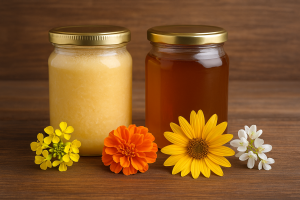
Each flower’s nectar offers a unique sugar profile. If nectar contains more glucose than fructose, it leads to quicker crystallization. Consequently, honey from mustard, coriander, or sunflower flowers crystallizes much faster than that from Acacia or Jamun.
2. Temperature
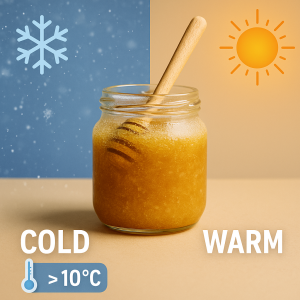
Cooler conditions, especially below 10°C, accelerate crystallization. That’s why honey stored in refrigerators often turns grainy or solid. Most labels around the world even warn: “Do not refrigerate honey.”
In contrast, warmer climates slow down the process, helping honey remain liquid longer.
3. Movement (or Lack of It)
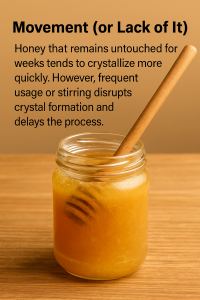
Honey that remains untouched for weeks tends to crystallize more quickly. However, frequent usage or stirring disrupts crystal formation and delays the process.
4. Presence of Natural Particles
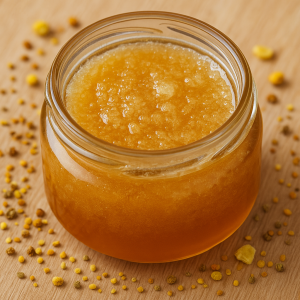
Raw honey retains tiny particles like pollen, wax, and even microscopic dust. These act as nucleation points, triggering crystal formation. That’s why raw, unprocessed honey crystallizes faster than filtered or heated versions.
Why Commercial Honey Doesn’t Crystallize (And Why That’s Bad)
You’ve probably noticed that honey from major commercial brands never crystallizes. So, why does that happen?
Because producers often:
-
Heat the honey excessively (which denatures natural compounds)
-
Ultrafilter it to remove pollen and particles
-
Mix it with synthetic sugar syrups like high fructose corn syrup (HFCS) or rice syrup
These treatments strip honey of its nutritional and enzymatic richness. While the product may appear perfect on shelves, it loses much of its health value.
So, the more “perfect” your honey looks, the more likely it has been processed or adulterated.
The Big Irony: Crystallized Honey Is Rejected in India
In India, the myth that crystallized honey is fake continues to mislead even well-educated consumers.
This misconception causes several issues:
-
Genuine beekeepers struggle to sell pure honey
-
India exports massive volumes of raw honey to foreign countries
-
Local buyers unknowingly choose adulterated products over authentic ones
In contrast, countries like the USA and Germany market crystallized honey as “set honey,” celebrating it as raw, natural, and unaltered.
Mustard Honey: The Most Misunderstood Honey in India
Did you know that over 90% of India’s mustard honey gets exported?
That’s because mustard honey crystallizes quickly—often within weeks. Local buyers, unaware of the truth, mistakenly reject it as spoiled or tampered.
Meanwhile, international markets welcome it as a hallmark of purity.
Is Crystallized Honey Safe to Eat?
Absolutely, yes.
Crystallized honey is not only safe, but it’s also a reliable sign of unprocessed, chemical-free authenticity. In fact, archaeologists discovered crystallized honey in Egyptian pyramids that remained edible after 3000 years!
Depending on the crystallization rate:
-
Fast crystallization leads to a creamy, smooth texture.
-
Slow crystallization results in larger crystals and a grainy texture.
Regardless of form, both are equally safe and nutritious.
How to Turn Crystallized Honey Back to Liquid
If you prefer your honey in liquid form, don’t worry—it’s easy to reverse crystallization:
-
Place the jar in warm water (below 45°C) for several minutes.
-
Alternatively, set it under mild sunlight until it liquefies.
However, never microwave or overheat honey, as high temperatures degrade its natural enzymes and nutrients.
Common Misconceptions About Crystallized Honey
Many people wrongly believe:
-
Crystallized honey is mixed with sugar or molasses
-
It’s spoiled or expired
-
It’s not real honey
-
Only liquid honey is genuine
These myths stem from a lack of awareness. In truth, the absence of crystallization can indicate artificial syrups or over processing.
Let’s Educate, Not Discard
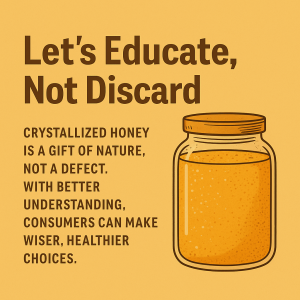
If these myths continue to spread, we will:
-
Undermine the value of real honey
-
Encourage the rise of adulterated products
-
Push ethical beekeepers out of business
It’s time to change the narrative. Crystallized honey is a gift of nature, not a defect. With better understanding, consumers can make wiser, healthier choices.
CONCLUSION: Crystallization Is Proof, Not a Problem
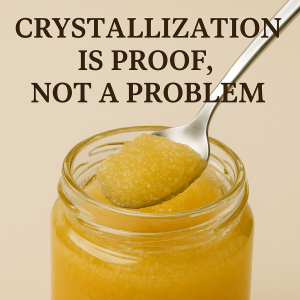
Let’s be clear: crystallization is a natural process in genuine honey. Each variety transitions at its own pace based on nectar type, sugar ratio, and storage temperature.
Instead of fearing this change, we should respect it.
So, the next time you see a jar of crystallized honey:
-
Don’t discard it.
-
Don’t doubt it.
-
Celebrate it—and share the truth with others.
Because only fake honey stays liquid forever. Real honey evolves. And that’s what makes it real.
____________________________________________________________________________________________________________________________________________________________________________

